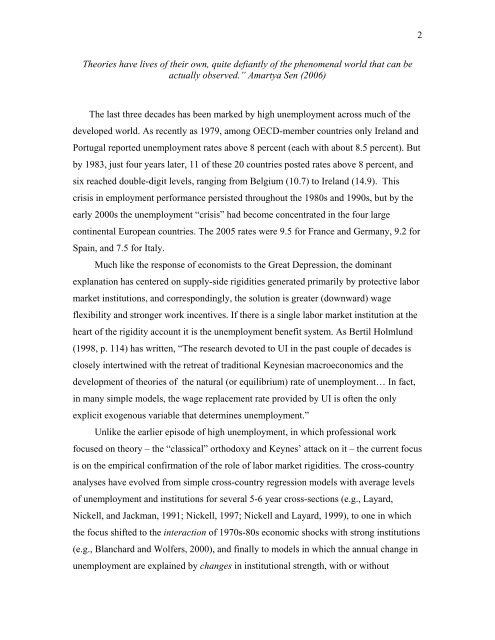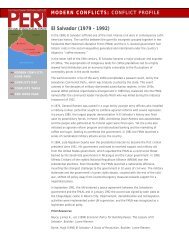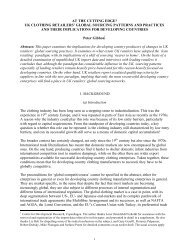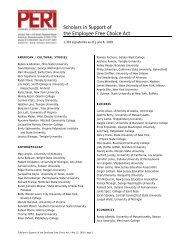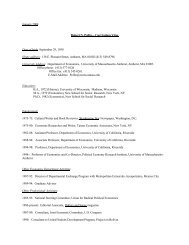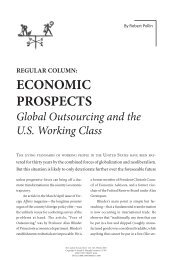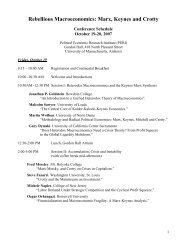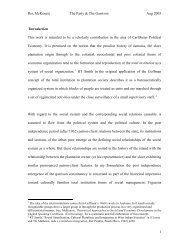Are Labor Market Institutions Really at the Root of Unemployment ...
Are Labor Market Institutions Really at the Root of Unemployment ...
Are Labor Market Institutions Really at the Root of Unemployment ...
You also want an ePaper? Increase the reach of your titles
YUMPU automatically turns print PDFs into web optimized ePapers that Google loves.
2<br />
Theories have lives <strong>of</strong> <strong>the</strong>ir own, quite defiantly <strong>of</strong> <strong>the</strong> phenomenal world th<strong>at</strong> can be<br />
actually observed.” Amartya Sen (2006)<br />
The last three decades has been marked by high unemployment across much <strong>of</strong> <strong>the</strong><br />
developed world. As recently as 1979, among OECD-member countries only Ireland and<br />
Portugal reported unemployment r<strong>at</strong>es above 8 percent (each with about 8.5 percent). But<br />
by 1983, just four years l<strong>at</strong>er, 11 <strong>of</strong> <strong>the</strong>se 20 countries posted r<strong>at</strong>es above 8 percent, and<br />
six reached double-digit levels, ranging from Belgium (10.7) to Ireland (14.9). This<br />
crisis in employment performance persisted throughout <strong>the</strong> 1980s and 1990s, but by <strong>the</strong><br />
early 2000s <strong>the</strong> unemployment “crisis” had become concentr<strong>at</strong>ed in <strong>the</strong> four large<br />
continental European countries. The 2005 r<strong>at</strong>es were 9.5 for France and Germany, 9.2 for<br />
Spain, and 7.5 for Italy.<br />
Much like <strong>the</strong> response <strong>of</strong> economists to <strong>the</strong> Gre<strong>at</strong> Depression, <strong>the</strong> dominant<br />
explan<strong>at</strong>ion has centered on supply-side rigidities gener<strong>at</strong>ed primarily by protective labor<br />
market institutions, and correspondingly, <strong>the</strong> solution is gre<strong>at</strong>er (downward) wage<br />
flexibility and stronger work incentives. If <strong>the</strong>re is a single labor market institution <strong>at</strong> <strong>the</strong><br />
heart <strong>of</strong> <strong>the</strong> rigidity account it is <strong>the</strong> unemployment benefit system. As Bertil Holmlund<br />
(1998, p. 114) has written, “The research devoted to UI in <strong>the</strong> past couple <strong>of</strong> decades is<br />
closely intertwined with <strong>the</strong> retre<strong>at</strong> <strong>of</strong> traditional Keynesian macroeconomics and <strong>the</strong><br />
development <strong>of</strong> <strong>the</strong>ories <strong>of</strong> <strong>the</strong> n<strong>at</strong>ural (or equilibrium) r<strong>at</strong>e <strong>of</strong> unemployment… In fact,<br />
in many simple models, <strong>the</strong> wage replacement r<strong>at</strong>e provided by UI is <strong>of</strong>ten <strong>the</strong> only<br />
explicit exogenous variable th<strong>at</strong> determines unemployment.”<br />
Unlike <strong>the</strong> earlier episode <strong>of</strong> high unemployment, in which pr<strong>of</strong>essional work<br />
focused on <strong>the</strong>ory – <strong>the</strong> “classical” orthodoxy and Keynes’ <strong>at</strong>tack on it – <strong>the</strong> current focus<br />
is on <strong>the</strong> empirical confirm<strong>at</strong>ion <strong>of</strong> <strong>the</strong> role <strong>of</strong> labor market rigidities. The cross-country<br />
analyses have evolved from simple cross-country regression models with average levels<br />
<strong>of</strong> unemployment and institutions for several 5-6 year cross-sections (e.g., Layard,<br />
Nickell, and Jackman, 1991; Nickell, 1997; Nickell and Layard, 1999), to one in which<br />
<strong>the</strong> focus shifted to <strong>the</strong> interaction <strong>of</strong> 1970s-80s economic shocks with strong institutions<br />
(e.g., Blanchard and Wolfers, 2000), and finally to models in which <strong>the</strong> annual change in<br />
unemployment are explained by changes in institutional strength, with or without


